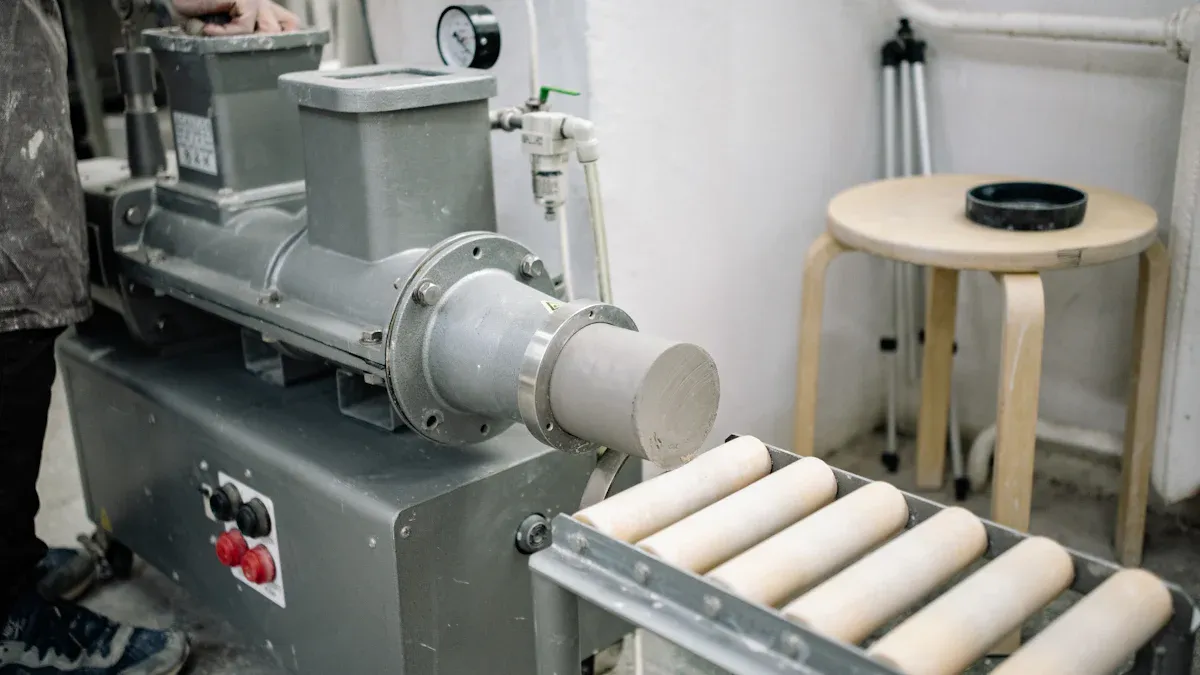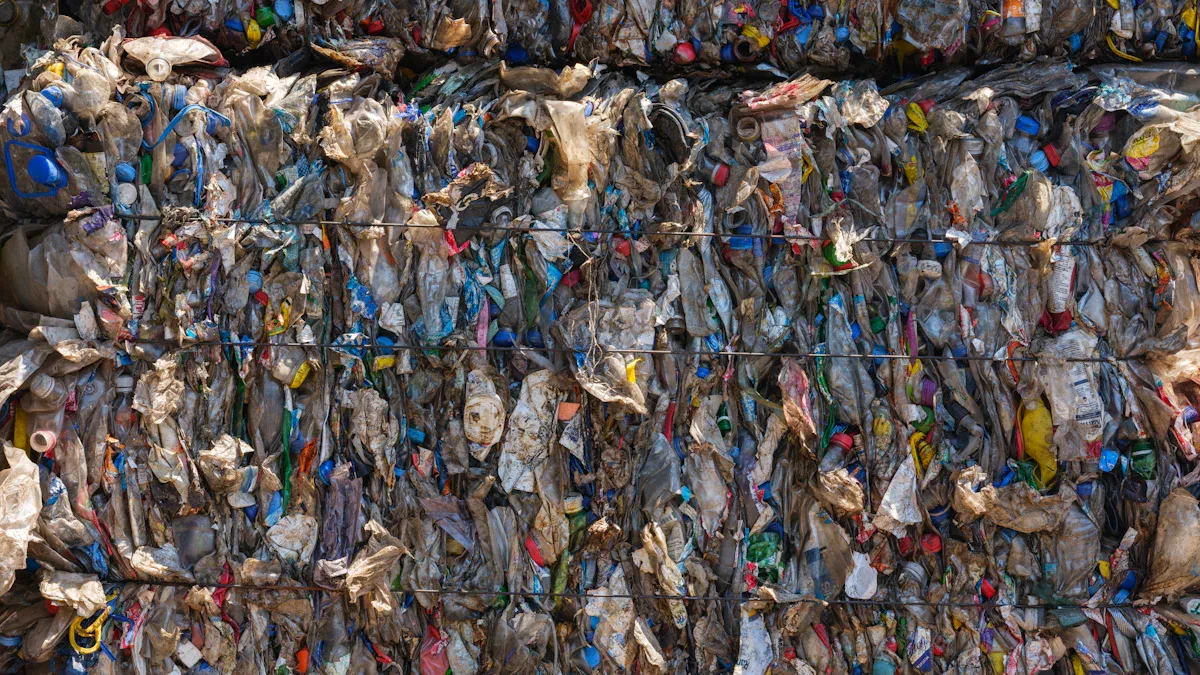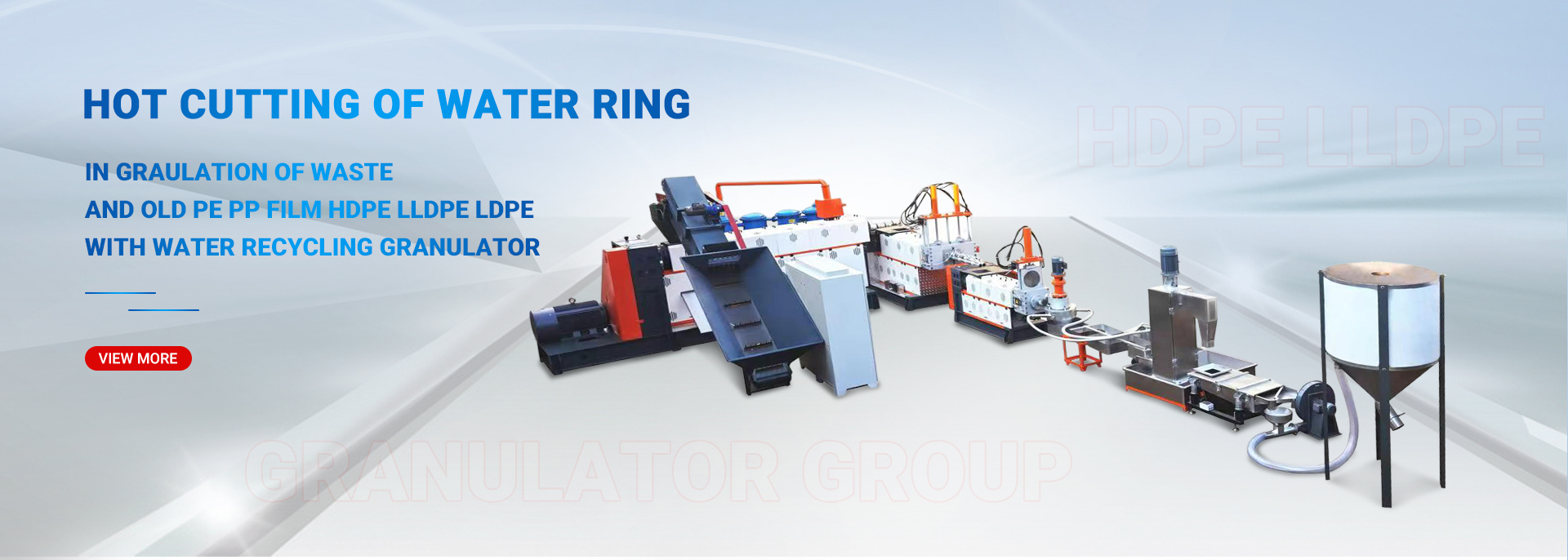
Operators achieve optimal results by following essential steps when using an Under water pellet making granulator for plastic waste material recycling purpose. A systematic approach promotes safety and efficiency. The Under water pellet making granulator for plastic w ensures high-quality pellet production in recycling operations.
Key Takeaways
- Inspect and maintain the granulator regularly by checking blades, water flow, and temperature to ensure smooth operation and high-quality pellets.
- Prepare clean, sorted plastic waste and monitor pellet size and shape closely to prevent jams and produce consistent, reliable pellets.
- Follow safety protocols by wearing protective gear, performing safety checks, and responding quickly to alarms to protect operators and equipment.
Under water pellet making granulator for plastic waste material recycling purpose

Key Functions of the Granulator
The Under water pellet making granulator for plastic waste material recycling purpose transforms melted plastic waste into uniform pellets. Operators feed shredded plastic into a hopper. The machine uses a twin-screw extruder barrel with controlled heating zones to melt and mix the plastic. Vacuum degassing ports remove moisture and air, while a screen pack filters out debris. A gear pump stabilizes the melt pressure before pelletizing. The cutter assembly slices the molten plastic directly in a water bath, which cools and solidifies the pellets instantly. Motors and drives power the screws and cutter, often using variable-frequency drives for energy efficiency. Safety features such as shaft seals, emergency stops, and overload protection help prevent jams and accidents. Regular maintenance includes inspecting and replacing worn parts like screw flights and cutting blades.
Tip: Consistent water flow and sharp cutter blades ensure uniform pellet size and reduce downtime.
Importance in Plastic Waste Recycling
The Under water pellet making granulator for plastic waste material recycling purpose plays a vital role in recycling operations. It handles a wide range of plastics, including PP, PE, PS, ABS, PA, PVC, and PET. This flexibility allows recycling facilities to process both rigid and soft plastic waste, as shown below:
| Plastic Waste Category | Examples of Suitable Materials for Underwater Pelletizing Granulators |
|---|---|
| Rigid Plastic Waste | HDPE rigid, PP pipes, ABS flakes, PS flakes, EPS/EPE/XPS foams |
| Soft Plastic Waste | LDPE agricultural film, LLDPE stretch film, HDPE bags, BOPP, CPP, OPP, POF films, fiber materials |
| Film Materials (after washing) | HDPE, LDPE, PP films |
Under water pellet making granulator for plastic waste material recycling purpose systems deliver higher throughput and smoother pellets than traditional strand pelletizing. Automated water filtration reduces downtime and operator intervention, making the process more efficient and reliable.
Preparing the Machine and Materials
Equipment Inspection and Readiness
Operators must ensure the underwater pellet making granulator is in optimal condition before starting. A thorough inspection of the granulator blades helps prevent unexpected breakdowns. The following steps outline a recommended inspection routine:
- Inspect granulator blades visually and by touch to check for chips, cracks, or uneven edges. Replace any blade with significant damage.
- Measure blade thickness, width, and straightness using precise tools. Record these measurements before sharpening.
- Log all inspection results and maintenance actions, including dates and blade conditions, in a maintenance log.
- Store blades in a dry, clean area, away from moisture and chemicals. Use racks or holders to prevent blade edges from touching.
- Always handle blades with gloves, use both hands, and transport them in protective cases. Avoid stacking blades directly.
Operators should also review the spare-parts list and identify critical parts to keep on site. Maintenance staff benefit from regular training on the mechanical aspects of the equipment. Scheduling follow-up visits with the supplier helps maintain high product quality.
Preparing Plastic Waste Materials
Plastic waste must be clean and free from contaminants. Operators sort materials by type and remove any metal, paper, or organic debris. Shredding the plastic into uniform pieces ensures consistent feeding into the extruder. Proper preparation of materials leads to smoother operation and higher-quality pellets.
Tip: Consistent material size and cleanliness reduce the risk of jams and improve pellet uniformity.
Safety Checks and Personal Protective Equipment
Safety remains a top priority. Operators wear gloves, safety goggles, and protective clothing when handling blades and plastic waste. They check emergency stops and safety interlocks before starting the machine. Clear walkways and organized tools help prevent accidents. Regular safety checks protect both operators and equipment.
Setting Up Water and Temperature Systems
Adjusting Water Flow and Filtration Systems
Operators set up the water system before starting the pelletizing process. The water flow must remain steady to cool and transport the pellets. They check the water pump and ensure that the flow rate matches the machine’s requirements. Clean water prevents contamination and keeps the pellets smooth. Operators inspect the filtration system for clogs or debris. They replace filters if needed to maintain clear water.
Tip: A well-maintained filtration system reduces downtime and improves pellet quality.
The die face and rotating cutter operate fully immersed in water. This setup allows the pellets to cool quickly and move away from the cutting area. The water carries the pellets in a slurry to the dewatering and drying stages. Operators monitor the water temperature and clarity throughout the process.
Preheating and Monitoring Temperature Controls
Proper temperature control ensures high-quality pellets. Operators preheat the extruder and die face to the recommended range. Most underwater pelletizing systems produce pellets at a maximum temperature of about 85°C. Some advanced systems, such as the i-heat process, reach up to 110°C for special materials like wood-plastic composites. For PLA pellets, the die face operates between 50°C and 90°C.
- Standard pelletizing: up to 85°C
- i-heat process: up to 110°C
- PLA pelletizing: 50°C to 90°C
Operators use control panels to monitor and adjust temperatures. They watch for any sudden changes that could affect pellet shape or cause sticking. Cooling begins immediately in the water-filled cutting chamber, which prevents pellets from sticking together and ensures a uniform product.
Starting the Extrusion and Pelletizing Process
Feeding Plastic Melt into the Extruder
Operators begin by introducing the prepared plastic feedstock into the extruder hopper. The extruder heats and compresses the plastic, turning it into a molten state. This molten plastic passes through a screen pack, which removes any remaining contaminants. Clean melt ensures that the final pellets have high purity and consistent quality.
A melt pump follows the screen pack. This pump controls the flow and pressure of the molten plastic. Steady pressure is important because it helps maintain the correct volume and shape of each pellet. The melt then moves to the die plate, where it will be cut into pellets. Operators monitor the temperature and pressure closely during this stage. Any sudden changes can affect pellet quality.
Tip: Operators should always check the screen pack and melt pump before starting. Clean equipment prevents blockages and keeps the process running smoothly.
Initiating the Pelletizer and Locking Mechanisms
Once the molten plastic reaches the die plate, operators activate the pelletizer. The pelletizer uses sharp rotating blades to cut the plastic as it exits the die holes. These blades must be properly aligned and securely locked in place. Proper locking mechanisms prevent movement during operation, which could cause uneven pellets or damage to the machine.
Operators check that all safety covers and interlocks are engaged. They also verify that the water flow in the cutting chamber is steady. Water cools the pellets instantly and carries them away from the cutting area. If the water flow is too low, pellets may stick together or lose their shape.
A quick checklist for this stage includes:
- Confirming blade sharpness and alignment
- Securing all locking mechanisms
- Engaging safety covers and interlocks
- Checking water flow and temperature
Note: Regular inspection of the pelletizer blades and locking systems reduces the risk of accidents and ensures consistent pellet size.
Synchronizing Extrusion and Underwater Cutting
Synchronization between the extrusion speed and the underwater cutting system is essential. The extruder must push out molten plastic at a rate that matches the speed of the rotating cutter. If the speeds do not match, pellet size and shape can vary, leading to quality issues.
Operators use control panels to adjust both the extruder and cutter speeds. They watch for signs of problems, such as uneven pellets or jams in the cutting chamber. Common issues during this process include strand migration, shrink voids, doubles or zippers, cracked knives, fines, tails, and poor strand control.
| Common Issue | Description | Causes | Prevention/Correction Methods |
|---|---|---|---|
| Strand Migration | Strands bunch on one side of the feed table, reducing pellet quality and causing processing issues. | Misalignment of pelletizer cutting plane and stranding plate; inconsistent gap or diameter of lower feed roll. | Ensure cutting plane is parallel to stranding plate; maintain consistent feed roll gap and diameter. |
| Shrink Voids | Pellets have dimples or hollow cores due to improper cooling. | Improper strand tempering; process water temperature too hot or cold; insufficient soak time; entrained volatiles. | Control water temperature to match polymer; allow sufficient cooling time; check vacuum port to remove volatiles. |
| Doubles/Zippers | Pellets attached end-to-end or tangentially by thin polymer film. | Process water too hot; low water flow; die holes too close causing die swell. | Lower water temperature; increase water flow; use die with fewer holes spaced further apart. |
| Cracked Knife | Bed knife cracks during rotation or installation, causing costly damage. | Excessive torque when mounting; improper handling of Invar alloy plug. | Follow manufacturer’s torque recommendations; careful installation procedures. |
| Fines | Small particles that affect bulk density and processing. | Cutting strand too cold; dull rotor or bed knives; improper rotor material; entrained air in post-cut apparatus. | Cut strand near Vicat softening point; use suitable rotor materials; maintain sharp cutting edges; avoid entrained air. |
| Tails | Protrusions or smears on pellet edges indicating poor cutting. | Dull rotor or bed knife; improper machine gap; nicks or grooves on die plate or blades. | Replace or sharpen rotor and bed knife; adjust machine gap; inspect and repair die plate and blades. |
| Poor Strand Control | Strands not presented perpendicular to cutter, causing angled cuts and crossing strands. | Misaligned or worn feed rolls; improper strand tempering; worn stranding plate; excessive cutter RPM. | Maintain feed rolls in good condition and alignment; ensure proper strand tempering; avoid excessive cutter speed. |
Operators prevent these issues by maintaining equipment, monitoring process parameters, and making timely adjustments. They also keep detailed records of any problems and solutions. This practice helps improve future operations and ensures high-quality pellet production.
Alert: Immediate action is required if operators notice changes in pellet appearance or machine sounds. Quick response prevents larger problems and reduces downtime.
Monitoring Pellet Formation and Quality

Observing Pellet Size, Shape, and Consistency
Operators must watch pellet formation closely during production. Uniform pellet size and shape play a key role in producing high-quality recycled plastic. When pellets look the same, they melt evenly in later processes. This helps manufacturers avoid defects in finished parts.
- Uniform pellet size and shape support consistent melting.
- Variations in pellet geometry can cause incomplete melting and defects.
- Fines (tiny particles) and large chunks disrupt process stability.
- Consistent pellets help the hopper feed material smoothly, preventing blockages.
- Stable pellet size supports the screw and feed throat design for steady melting.
Operators use visual checks and sometimes calipers to measure pellet size. They look for smooth, round, or cylindrical shapes, depending on the die design. Pellets should not have tails, cracks, or attached strings. If operators see too many fines or oversized chunks, they know the process needs adjustment.
Tip: Operators should remove samples at regular intervals and compare them to reference samples. This practice helps catch problems early and keeps pellet quality high.
Adjusting Process Parameters for Quality Control
Operators can improve pellet quality by adjusting several process parameters. Each parameter affects the final product in a different way.
- Adjusting particle size and distribution helps create uniform and dense pellets.
- Controlling moisture content within the right range increases pellet strength and durability.
- Managing temperature and time during conditioning, such as steam conditioning, influences pellet quality.
- Choosing the right binder improves pellet cohesion and mechanical properties.
- Setting equipment specifications, like die and roller parameters, affects pellet formation and consistency.
Operators use the control panel to fine-tune these settings. For example, if pellets appear too soft or stick together, lowering the water temperature or increasing the cutter speed can help. If pellets break apart easily, operators may need to adjust moisture levels or check for worn blades.
A simple checklist for quality control includes:
- Checking pellet size and shape every 30 minutes
- Monitoring moisture content and adjusting drying time
- Inspecting die and cutter blades for wear
- Recording all changes and results in a logbook
Note: Quick adjustments and careful monitoring help maintain stable production and high-quality pellets. Operators who track changes and results can solve problems faster and improve future batches.
Managing Drying and Collection of Pellets
Operating the Pellet Dryer System
Operators use a pellet dryer system to remove water from the freshly cut pellets. Most facilities choose a centrifugal dryer. In this system, pellets enter at the bottom. A rotating shaft with lifting vanes spins the pellets upward, removing water as they rise. The pellets exit at the top, dry and ready for collection.
Operators must control the process water temperature. Each type of plastic needs a specific temperature to avoid malformed pellets. Continuous water circulation through pipes allows the dryer and water-treatment equipment to be placed away from the main machine. A water bypass system helps maintain water temperature during cutter head changes by diverting flow from the cutting chamber. Operators can adjust cutter blade pressure using manual, hydraulic, spring-loaded, or pneumatic systems. Many modern dryers use PLC controllers for automated valve operation and pelletizer startup or shutdown.
| Operational Setting | Description |
|---|---|
| Pellet Dryer Type | Centrifugal dryer with bottom entry and top exit for de-watered pellets. |
| Process Water Temperature Control | Adjusted for polymer properties to prevent pellet defects. |
| Water Circulation | Continuous piping allows remote dryer and water-treatment placement. |
| Water Bypass System | Maintains temperature during cutter head changes. |
| Cutter Blade Pressure Control | Manual, hydraulic, spring-loaded, or pneumatic adjustment options. |
| Automation | PLC controller for automated operation and safety. |
Tip: Operators should monitor the dryer system for unusual sounds or vibrations. Early detection of problems prevents downtime.
Collecting, Storing, and Handling Finished Pellets
Proper collection and storage keep pellets clean and safe. Facilities often use customized containment systems that fit their needs. Operators must follow EPA and local regulations to avoid penalties. Regular inspections help find and fix problems early.
- Use containment systems designed for the facility’s needs.
- Follow all environmental rules and guidelines.
- Inspect and maintain containment systems often.
- Train employees to handle pellets and respond to spills.
- Choose strong materials like steel or fiberglass for containment.
- Use secondary containment, spill berms, or railcar systems for large operations.
- Install drainage filters to stop pellets from entering water systems.
- Place containment pallets or basins in indoor areas to catch spills.
Note: Good handling and storage practices protect the environment and keep pellet quality high.
Troubleshooting Common Issues
Resolving Blockages and Jams
Operators often encounter blockages or jams in underwater pellet making granulators. These issues usually occur at the die plate or in the water flow system. When a blockage happens, operators first stop the machine to prevent damage. They inspect the die holes for any trapped plastic or debris. Using specialized tools, they clear the obstruction carefully. If the blockage persists, they may need to remove the die plate for a thorough cleaning. Regular cleaning of the water filtration system also helps prevent jams. Operators check for proper water flow and remove any buildup in the pipes or filters.
Tip: Routine inspection and cleaning reduce the risk of unexpected shutdowns and keep the process running smoothly.
Addressing Irregular Pellet Quality
Irregular pellet quality can result from several factors. Operators follow a systematic approach to identify and fix these problems:
- They check for die-hole blockages caused by contaminants or poorly mixed fillers and clean the die holes if needed.
- They inspect the die plate insulation and heaters. Damaged insulation or failed heaters can lower die temperature and cause pellet inconsistency.
- They verify that die holes are the correct size to maintain proper polymer flow.
- They keep the die temperature about 25°F higher than the polymer melt temperature to avoid freeze-off and pellet deformity.
- They monitor polymer velocity through the die holes to prevent flow problems and pellet tails.
- They examine die and blade surfaces for wear, which can create fines or tails on pellets.
- They control melt temperature to avoid overheating, which can deform pellets.
- They optimize drying conditions, including water temperature and airflow, to reduce fines and moisture.
- They check for feedstock issues like bridging in the hopper or surging in the extruder.
- They consider environmental factors such as humidity, which can increase pellet moisture after drying.
Responding to System Alarms and Faults
System alarms and faults alert operators to potential problems. When an alarm sounds, operators review the control panel for error codes. They follow the manufacturer’s troubleshooting guide to identify the cause. Common alarms include over-temperature, low water flow, or motor overload. Operators address each issue step by step, resetting the system only after resolving the fault. Keeping a log of alarms and corrective actions helps improve future troubleshooting and ensures safe operation.
Note: Quick response to alarms protects both equipment and product quality.
Cleaning and Maintaining the Equipment
Safe Shutdown and Drainage Procedures
Operators must follow a strict shutdown process to protect both the machine and themselves. First, they stop the feed to the extruder and allow the remaining plastic to clear the system. Next, they turn off the heating elements and let the equipment cool to a safe temperature. Operators then shut down the water flow and open the drainage valves. This step removes water from the cutting chamber and pipes. They always wear gloves and safety goggles during this process. Proper shutdown prevents burns, electrical hazards, and water leaks.
Tip: Operators should post a shutdown checklist near the control panel for quick reference.
Routine Cleaning and Water Removal
Routine cleaning keeps the granulator running smoothly. Operators remove any plastic residue from the die plate and cutter blades using approved tools. They wipe down surfaces to prevent buildup. Water tanks and filters require regular flushing to remove debris and prevent bacterial growth. Operators inspect and clean the water pump and hoses to ensure clear flow. They dry all parts before reassembly to avoid rust and corrosion.
- Remove plastic residue from key parts
- Flush water tanks and filters
- Inspect and clean pumps and hoses
- Dry all components before use
Preventive Maintenance and Inspection
Preventive maintenance extends equipment life and reduces downtime. Operators schedule regular inspections for wear on blades, seals, and bearings. They check for loose bolts and signs of leaks. Lubrication of moving parts keeps the system efficient. Operators record all maintenance actions in a logbook. This record helps track issues and plan future repairs.
| Maintenance Task | Frequency | Responsible Person |
|---|---|---|
| Blade Inspection | Weekly | Operator |
| Seal Replacement | Monthly | Technician |
| Lubrication | Bi-weekly | Operator |
| Leak Check | Weekly | Operator |
Note: Consistent maintenance ensures safe operation and high-quality pellet production.
Operators achieve safe, efficient, and high-quality results by following each step for the Under water pellet making granulator for plastic waste material recycling purpose. Regular maintenance and monitoring keep the system reliable.
Consistent checks help prevent costly downtime.
Daily Checklist:
- Inspect equipment and blades
- Prepare clean, sorted plastic
- Monitor water flow and temperature
- Check pellet quality
- Record maintenance actions
FAQ
How often should operators clean the underwater pellet making granulator?
Operators should clean the granulator after each production run. Regular cleaning prevents residue buildup and ensures consistent pellet quality.
What safety gear do operators need during operation?
Operators need gloves, safety goggles, and protective clothing. These items protect against sharp blades, hot surfaces, and chemical exposure.
Can the granulator process mixed plastic types?
The granulator works best with sorted plastics. Mixed types may cause inconsistent pellets or machine blockages.
Tip: Always sort and clean plastic waste before processing for optimal results.
Post time: Jul-14-2025



